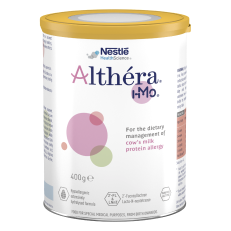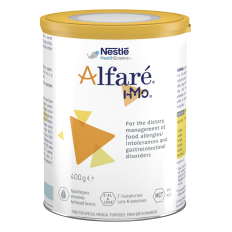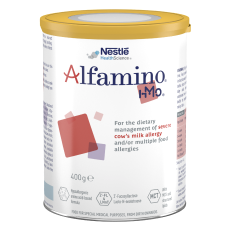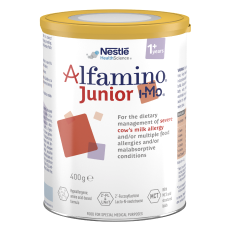Cows milk protein allergy (CMPA) is one of the most common food allergies in infants
Cow’s milk protein allergy (CMPA) often presents with diverse and non-specific symptoms, making it challenging to diagnose and manage. At Nestlé Health Science, we understand this challenge and are committed to supporting healthcare professionals, patients and caregivers in caring for infants with CMPA.
KEY FACTS ABOUT COW’S MILK PROTEIN ALLERGY
Cow’s milk protein allergy (CMPA) is one of the most common food allergies in the first year of life. It occurs when an infant’s immune system reacts abnormally to the proteins in cow’s milk, which are either transferred from the mother while breastfeeding or from cow’s milk protein-containing formulas and complementary food. The immune reaction may be immunoglobulin (Ig)E-mediated, non-IgE-mediated, or mixed. The reactions can be immediate (early) reactions, occurring from minutes to hours after exposure, and/or delayed (late) reactions, which can manifest 48 hours or even a week following ingestion. Immediate reactions are more likely to involve IgE, but combinations of immediate and delayed reactions can occur in some infants.1
Prospective cohort studies in Europe suggest a 10-year prevalence of 1.9% to 4.9% for CMPA in infancy.2 A meta-analysis supports this, with incidence rates of CMPA shown to be between 2% and 3% in infants less than 1 year old.3

The majority of children outgrow CMPA: 50% children outgrow CMPA by 1-2 years, this increases to 80% before the age of 4. 90% of CMPA resolves by 6 years of age.1,3

CMPA is an immune-mediated disease. It is associated with an overactive immune system, increased gut permeability and dysbiosis, which might affect the maturation of an infants’ immune system.4-10 This can lead to an increased risk of infections and future allergies.11-13
Without dietetic support, children with CMPA and/or multiple food allergies are at an increased risk of nutritional deficiencies,15 which can lead to significantly lower growth parameters.16 As infants with food allergies start complementary feeding, continued dietetic support is therefore important, as it can be challenging for caregivers to provide an appropriate elimination diet which ensures a sufficient energy and nutrient intake.14

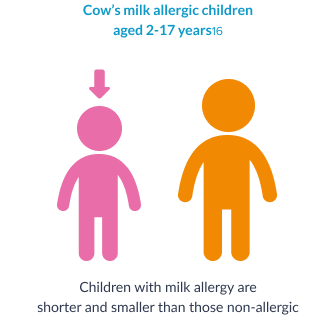
Non-allergic food hypersensitivities, such as intolerances, result from the inability to digest certain components of foods, i.e. lactose or fructose, or, less commonly, food colouring, additives or preservatives. Non-allergic food hypersensitivities do not involve the immune system and are much more common than food allergies.

Food allergies arise through an immunological reaction to certain allergens in food. These allergens are almost always proteins. Other components in food, such as lactose and other carbohydrates, do not commonly act as allergens. Certain allergens
cause more reactions than others. Here are eight most common allergens accounting for approximately 90 percent of all allergic reactions to food in children.18
Allergy is on the increase among infants and young children.1
Lactose intolerance results from a decreased ability to digest and absorb lactose (the sugar present in milk) due to a lack of the enzyme lactase. It is very rare in infants and children younger than 5 years,19 including those with
CMPA.
Breast milk naturally contains a high amount of lactose, which is beneficial for healthy infant growth and development. It provides energy and supports the absorption of calcium. Lactose also promotes the development of a healthy gut
microbiota.
20 Therefore, lactose should not be eliminated from the infant’s diet unnecessarily.
| CMPA | Lactose intolerance |
| 3% of infants ≤ 1 year1,21 | Very rare in children ≤ 5 years19 65% of people globally have lactose intolerance in adulthood21 |
NESTLÉ HEALTH SCIENCE: SUPPORTING COW’S MILK PROTEIN ALLERGY DIAGNOSIS AND MANAGEMENT
CMPA can be a challenge to diagnose given the large variability in number and severity of the symptoms, and the fact that some of them are perfectly normal for infants to experience.
We understand this challenge and are committed to provide
expert-developed tools, nutritional solutions and support for healthcare professionals to help facilitate the earlier diagnosis and appropriate management of infants and young children with CMPA.

SIGNS AND SYMPTOMS
Inconsolable crying, colic, skin rashes, vomiting, diarhoea, and constipation are all common signs and symptoms of CMPA, especially in early infancy.

CONSIDER CMPA
Leading experts have developed the Cow’s Milk-related Symptom Score (CoMiSS®) to help healthcare professionals recognize and assess non-specific signs and symptoms that could be indicative of CMPA.

CLARIFY THE DIAGNOSIS
Diagnosis of CMPA can be challenging, and few tests are available to help assess the presence of CMPA. The gold standard for diagnosing CMPA is the elimination diet, which is free from cow’s milk protein, followed by a food challenge.
OUR RANGE OF TAILOR-MADE NUTRITIONAL SOLUTIONS
Nestlé Health Science has a range of nutritional solutions that are tailor-made to meet the specific needs of infants with CMPA. Our formulas are hypoallergenic and nutritionally complete to support normal growth and development, and are supplemented with HMO* (2’FL and LNnT) to support growing immune systems.
NESTLÉ’S HEALTH SCIENCE’S COMMITMENT TO CMPA EDUCATION
Nestlé Health Science is dedicated to developing and sharing leading scientific information and educational tools to support in the identification and management of CMPA for healthcare professionals and caregivers.

EXPERT CORNER: CMPA DIAGNOSIS
Leading experts in paediatric gastroenterology and food allergy answer common questions related to the diagnosis of CMPA in our online video series.

CASE STUDIES
Understand some of the diagnostic and management challenges - from the initial symptom presentation to diagnosis followed by the dietery management in a series of case studies.

SUPPORT FOR PARENTS AND CAREGIVERS
Information and tools are available for parents to support them along their CMPA journey.
* Structurally identical Human Milk Oligosaccharides (HMO) are not sourced from human milk
REFERENCES
- Koletzko S, et al. Diagnostic Approach and Management of Cow’s-Milk Protein Allergy in Infants and Children: ESPGHAN GI Committee Practical Guidelines. J Pediatr Gastroenterol Nutr 2012;55(2):221-229.
- Prescott SL, et al. A global survey on changing patterns of food allergy burden in children. World Allergy Organ J. 2013;6(1) :21.
- Høst A. Cow’s milk protein allergy and intolerance in infancy. Some clinical, epidemiological and immunological aspects. Pediatr Allergy Immunol. 1994;5:1-36.
- Jalonen T. Identical intestinal permeability changes in children with different clinical manifestations of cow’s milk allergy. J allergy Clin Immunol 1991;88(5):737-742.
- Crittenden RG and Bennett LE. Cow’s Milk Allergy: A Complex Disorder. J Am Coll Nutr 2005;24(6suppl):582S–591S.
- Thompson-Chagoyan OC, et al. Faecal Microbiota and Short-Chain Fatty Acid Levels in Faeces from Infants with Cow‘s Milk Protein Allergy. Int Arch Allergy Immunol 2011;156(3):325–332.
- Azad MB, et al. Infant gut microbiota and food sensitization: associations in the first year of life. Clin Exp Allergy 2015;45(3):632-643.
- Chin AM, et al. Morphogenesis and maturation of the embryonic and postnatal intestine. Semin Cell Dev Biol 2017;66:81-93.
- Tanaka M and Nakayama J. Development of the gut microbiota in infancy and its impact on health in later life. Allergol Int 2017;66(4):515-522.
- Dzidic M, et al. Gut Microbiota and Mucosal Immunity in the Neonate. Med Sci (Basel). 2018;6(3):56.
- Juntti H, et al. Cow’s Milk Allergy is Associated with Recurrent Otitis Media During Childhood. Acta Otolaryngol 1999;119(8):867-873.
- Tikkanen S, et al. Status of children with cow’s milk allergy in infancy by 10 years of Age. Acta Paediatr 2000; 89(10):1174-1180.
- Woicka-Kolejwa K, et al. Food allergy is associated with recurrent respiratory tract infections during childhood. Postepy Dermatol Alergol 2016;33(2):109-113.
- Meyer, R. Nutritional disorders resulting from food allergy in children. Pediatr Allergy Immunol. 2018; 29:689– 704.
- ASCIA 2017 – Food Allergy Clinical Update for Dietitians. Received from https://etrainingdiet.ascia.org.au/login/index.php on 5th June 2019.
- Robbins et al. Milk allergy is associated with decreased growth in U.S. children. J Allergy Clin Immunol. 2014 December; 134(6):1466-1468.
- Christie L, Hine RJ, Parker JG, Burks W. Food allergies in children affect nutrient intake and growth. J Am Diet Assoc 2002: 102: 1648.
- US FDA. Food Allergies: What You Need to Know. Available at: https://www.fda.gov/food/buy-store-serve-safe-food/what-you-need-know-about-food-allergies (accessed August 2020).
- Heyman MB, et al. Committee on Nutrition. Lactose intolerance in infants, children, and adolescents. Pediatrics. 2006;118(3):1279-86.
- Francavilla R et al. Effect of lactose on gut microbiota and metabolome of infants with cow’s milk allergy. Pediatr Allergy Immunol 2012;23:420-427.
- NIH. Lactose intolerance. Available at: https://ghr.nlm.nih.gov/condition/lactose-intolerance#statistics (accessed August 2020).
IMPORTANT NOTICE: Mothers should be encouraged to continue breastfeeding even when their babies have cow’s milk protein allergy. This usually requires qualified dietary counseling to completely exclude all sources of cow’s milk protein from the mothers’ diet. If a decision to use a special formula intended for infants is taken, it is important to follow the instructions on the label. Unboiled water, unboiled bottles or incorrect dilution can make babies ill. Incorrect storage, handling, preparation and feeding can eventually lead to adverse effects on the health of babies. Formula for special medical purposes intended for infants must be used under medical supervision.

